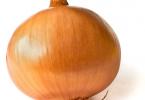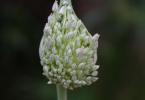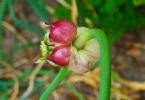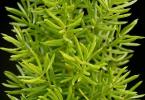Tail Flower

Intense burning sensation of the mouth, throat, lips and tongue; excessive drooling, choking and swelling of the throat, inability or difficulty swallowing (dysphagia); symptoms may continue to occur up to two weeks after ingestion. Ingestion of larger quantities can result in severe digestive upset; extreme difficulty breathing, rapid shallow gasps (dyspnea). If massive amounts are consumed the symptoms become much more severe and can include any or all of the above with the addition of convulsions, renal failure, coma and death. It is possible to recover from severe calcium oxalate poisoning, however, in most cases permanent liver, and kidney damage may have already occurred.
One of the more common toxins, insoluble calcium oxalate crystals can be found in many popular houseplants and ornamentals. The vast majority of these plants belong to the Araceae family and all cause a similar clinical syndrome. Within the Aracae, genera such as Alocasia, Arisaema, Caladium, Colocasia, Dieffenbachia and Philodendron contain calcium oxalate crystals in the form of raphides. The Araceae family is one of the most diverse in the plant kingdom, comprising over 3700 different species. When consumed, these plants cause an intense burning sensation of the mouth, throat, lips and tongue; excessive drooling, choking, gagging and potentially serious swelling of the throat that could cause difficulty or the inability to swallow (dysphagia). Symptoms can occur immediately or up to 2 hours after ingestion and may continue to occur for up to two weeks after ingestion.
All parts of these plants should be considered toxic, although the leaves of some species may contain little or no toxin. These plants contain special cells called idioblasts. Found in a number of plant species both poisonous and non-poisonous, idioblasts differ from neighboring cells in that they contain non-living substances like oil, latex, gum, resin, tannin, pigments or minerals. One of these substances is raphides or bundles of needlelike crystals of calcium oxalate that tend to be blunt at one end and sharp at the other. The crystals are packed in a gelatinous substance that contains free oxalic acid.
When animals chew on the leaves, flowers or stems of the plant, the tip of the idioblast is broken allowing saliva from the animal or sap from the plant to enter the cell. This in turn causes the gelatinous material to swell forcing the raphides (needle like calcium oxalate crystals) to violently shoot out from the cells into the surrounding area. The calcium oxalate crystals then penetrate and embed themselves into the tissues of the mouth, tongue, throat and stomach causing (in most cases) immediate discomfort and aggravation as would be expected when millions of microscopic needles are lodged in ones throat and mouth. The idioblasts may continue to expel raphides for a considerable amount of time after ingestion allowing the crystals to also embed themselves into lining of the stomach and intestine causing additional gastrointestinal upset.
In addition to calcium oxalate crystals some species may also contain proteinase (proteolytic enzymes) that break protein down into amino acids stimulating the release of kinins and histamines; which cause inflammation, affect blood pressure and stimulate pain receptors. Although kinins and histamines are part of the body’s natural response to tissue damage and foreign bodies, the inflammatory response will only serve to exacerbate the damage and irritation caused by the embedded calcium oxalate crystals.
In the vast majority of cases clinical signs will present immediately or within two hours of ingestion. Clinical signs include obvious pain and irritation that is generally expressed by violently shaking the head, drooling excessively, pawing at the mouth, gagging, vomiting or dry heaving. The animal may also whine, bark or yelp in an unusually hoarse or weak sounding voice. Other clinical signs include depression, diarrhea, inappetance and swelling of the mouth, throat and tongue. In some cases swelling may be so severe as to restrict oxygen intake resulting in dyspnea (shortness of breath, gasping for air). The crystals irritation of the stomach also commonly results in diarrhea.
Due to the fact that the plant is both bitter in taste and acts as an immediate irritant to the mouth, large ingestions are uncommon. If, however, a pet does manage to tolerate consuming a massive amount the plant clinical signs will be notably worse. So much so, that the vomiting and diarrhea can severely dehydrate the animal, cause electrolyte imbalances and send the animal into shock. In cases involving massive ingestions; cardiac abnormalities, dilated pupils, coma and death have been reported.
In most cases of calcium oxalate ingestion, treatment can be managed at home. Upon finding out that your pet may have ingested a plant containing calcium oxalate; the mouth should be rinsed and flushed thoroughly with water. The animal can then be given yogurt, milk, cheese or any other source of calcium to provide relief from the pain, by possibly precipitating some of the calcium oxalate crystals. In the vast majority of cases the pet will make a full recover within 12 to 24 hours of ingestion. In cases where the pet is experiencing more severe gastrointestinal upset, persistent vomiting, and diarrhea, they should be monitored carefully for signs of dehydration and provided fluid therapy if needed. Both as a preventative measure and in cases where there is obvious oral swelling it may be advisable to give the pet an antihistamine, such as diphenhydramine (Benadryl). This will help to reduce/prevent swelling, discomfort and avoid potential blockages of the airway related to the body’s inflammatory response. Typical dose rates are 2 to 4mg/kg by mouth or intramuscularly every 8 hours as needed.
To alleviate the gastrointestinal upset Kapectolin may be given at a dose rate of 1 to 2 ml/kg four times a day. Kapectolin provides a coating action that protects the stomach lining. Sucralfate may also be used as for gastrointestinal irritation as it reacts with the acids in the stomach to form a paste-like material capable of acting as a barrier between the stomach and its contents. Sucralfate is typically given to dogs weighing more the 60lbs: 1g every 6 to 8 hours; for dogs under 60 lbs: 0.5g every 6 to 8 hours; Cats: 0.25g every 8 to 12 hours to reduce irritation of the stomach and intestines.
If the airway becomes blocked due to swelling the pet should be kept under observation at a veterinary office until the swelling abates and the animal is breathing normally. Prevent further ingestion of the plant and consult a veterinarian.
Oilcloth Flower

Intense burning sensation of the mouth, throat, lips and tongue; excessive drooling, choking and swelling of the throat, inability or difficulty swallowing (dysphagia); symptoms may continue to occur up to two weeks after ingestion. Ingestion of larger quantities can result in severe digestive upset; extreme difficulty breathing, rapid shallow gasps (dyspnea). If massive amounts are consumed the symptoms become much more severe and can include any or all of the above with the addition of convulsions, renal failure, coma and death. It is possible to recover from severe calcium oxalate poisoning, however, in most cases permanent liver, and kidney damage may have already occurred.
One of the more common toxins, insoluble calcium oxalate crystals can be found in many popular houseplants and ornamentals. The vast majority of these plants belong to the Araceae family and all cause a similar clinical syndrome. Within the Aracae, genera such as Alocasia, Arisaema, Caladium, Colocasia, Dieffenbachia and Philodendron contain calcium oxalate crystals in the form of raphides. The Araceae family is one of the most diverse in the plant kingdom, comprising over 3700 different species. When consumed, these plants cause an intense burning sensation of the mouth, throat, lips and tongue; excessive drooling, choking, gagging and potentially serious swelling of the throat that could cause difficulty or the inability to swallow (dysphagia). Symptoms can occur immediately or up to 2 hours after ingestion and may continue to occur for up to two weeks after ingestion.
All parts of these plants should be considered toxic, although the leaves of some species may contain little or no toxin. These plants contain special cells called idioblasts. Found in a number of plant species both poisonous and non-poisonous, idioblasts differ from neighboring cells in that they contain non-living substances like oil, latex, gum, resin, tannin, pigments or minerals. One of these substances is raphides or bundles of needlelike crystals of calcium oxalate that tend to be blunt at one end and sharp at the other. The crystals are packed in a gelatinous substance that contains free oxalic acid.
When animals chew on the leaves, flowers or stems of the plant, the tip of the idioblast is broken allowing saliva from the animal or sap from the plant to enter the cell. This in turn causes the gelatinous material to swell forcing the raphides (needle like calcium oxalate crystals) to violently shoot out from the cells into the surrounding area. The calcium oxalate crystals then penetrate and embed themselves into the tissues of the mouth, tongue, throat and stomach causing (in most cases) immediate discomfort and aggravation as would be expected when millions of microscopic needles are lodged in ones throat and mouth. The idioblasts may continue to expel raphides for a considerable amount of time after ingestion allowing the crystals to also embed themselves into lining of the stomach and intestine causing additional gastrointestinal upset.
In addition to calcium oxalate crystals some species may also contain proteinase (proteolytic enzymes) that break protein down into amino acids stimulating the release of kinins and histamines; which cause inflammation, affect blood pressure and stimulate pain receptors. Although kinins and histamines are part of the body’s natural response to tissue damage and foreign bodies, the inflammatory response will only serve to exacerbate the damage and irritation caused by the embedded calcium oxalate crystals.
In the vast majority of cases clinical signs will present immediately or within two hours of ingestion. Clinical signs include obvious pain and irritation that is generally expressed by violently shaking the head, drooling excessively, pawing at the mouth, gagging, vomiting or dry heaving. The animal may also whine, bark or yelp in an unusually hoarse or weak sounding voice. Other clinical signs include depression, diarrhea, inappetance and swelling of the mouth, throat and tongue. In some cases swelling may be so severe as to restrict oxygen intake resulting in dyspnea (shortness of breath, gasping for air). The crystals irritation of the stomach also commonly results in diarrhea.
Due to the fact that the plant is both bitter in taste and acts as an immediate irritant to the mouth, large ingestions are uncommon. If, however, a pet does manage to tolerate consuming a massive amount the plant clinical signs will be notably worse. So much so, that the vomiting and diarrhea can severely dehydrate the animal, cause electrolyte imbalances and send the animal into shock. In cases involving massive ingestions; cardiac abnormalities, dilated pupils, coma and death have been reported.
In most cases of calcium oxalate ingestion, treatment can be managed at home. Upon finding out that your pet may have ingested a plant containing calcium oxalate; the mouth should be rinsed and flushed thoroughly with water. The animal can then be given yogurt, milk, cheese or any other source of calcium to provide relief from the pain, by possibly precipitating some of the calcium oxalate crystals. In the vast majority of cases the pet will make a full recover within 12 to 24 hours of ingestion. In cases where the pet is experiencing more severe gastrointestinal upset, persistent vomiting, and diarrhea, they should be monitored carefully for signs of dehydration and provided fluid therapy if needed. Both as a preventative measure and in cases where there is obvious oral swelling it may be advisable to give the pet an antihistamine, such as diphenhydramine (Benadryl). This will help to reduce/prevent swelling, discomfort and avoid potential blockages of the airway related to the body’s inflammatory response. Typical dose rates are 2 to 4mg/kg by mouth or intramuscularly every 8 hours as needed.
To alleviate the gastrointestinal upset Kapectolin may be given at a dose rate of 1 to 2 ml/kg four times a day. Kapectolin provides a coating action that protects the stomach lining. Sucralfate may also be used as for gastrointestinal irritation as it reacts with the acids in the stomach to form a paste-like material capable of acting as a barrier between the stomach and its contents. Sucralfate is typically given to dogs weighing more the 60lbs: 1g every 6 to 8 hours; for dogs under 60 lbs: 0.5g every 6 to 8 hours; Cats: 0.25g every 8 to 12 hours to reduce irritation of the stomach and intestines.
If the airway becomes blocked due to swelling the pet should be kept under observation at a veterinary office until the swelling abates and the animal is breathing normally. Prevent further ingestion of the plant and consult a veterinarian.
Painter's Pallette

Intense burning sensation of the mouth, throat, lips and tongue; excessive drooling, choking and swelling of the throat, inability or difficulty swallowing (dysphagia); symptoms may continue to occur up to two weeks after ingestion. Ingestion of larger quantities can result in severe digestive upset; extreme difficulty breathing, rapid shallow gasps (dyspnea). If massive amounts are consumed the symptoms become much more severe and can include any or all of the above with the addition of convulsions, renal failure, coma and death. It is possible to recover from severe calcium oxalate poisoning, however, in most cases permanent liver, and kidney damage may have already occurred.
One of the more common toxins, insoluble calcium oxalate crystals can be found in many popular houseplants and ornamentals. The vast majority of these plants belong to the Araceae family and all cause a similar clinical syndrome. Within the Aracae, genera such as Alocasia, Arisaema, Caladium, Colocasia, Dieffenbachia and Philodendron contain calcium oxalate crystals in the form of raphides. The Araceae family is one of the most diverse in the plant kingdom, comprising over 3700 different species. When consumed, these plants cause an intense burning sensation of the mouth, throat, lips and tongue; excessive drooling, choking, gagging and potentially serious swelling of the throat that could cause difficulty or the inability to swallow (dysphagia). Symptoms can occur immediately or up to 2 hours after ingestion and may continue to occur for up to two weeks after ingestion.
All parts of these plants should be considered toxic, although the leaves of some species may contain little or no toxin. These plants contain special cells called idioblasts. Found in a number of plant species both poisonous and non-poisonous, idioblasts differ from neighboring cells in that they contain non-living substances like oil, latex, gum, resin, tannin, pigments or minerals. One of these substances is raphides or bundles of needlelike crystals of calcium oxalate that tend to be blunt at one end and sharp at the other. The crystals are packed in a gelatinous substance that contains free oxalic acid.
When animals chew on the leaves, flowers or stems of the plant, the tip of the idioblast is broken allowing saliva from the animal or sap from the plant to enter the cell. This in turn causes the gelatinous material to swell forcing the raphides (needle like calcium oxalate crystals) to violently shoot out from the cells into the surrounding area. The calcium oxalate crystals then penetrate and embed themselves into the tissues of the mouth, tongue, throat and stomach causing (in most cases) immediate discomfort and aggravation as would be expected when millions of microscopic needles are lodged in ones throat and mouth. The idioblasts may continue to expel raphides for a considerable amount of time after ingestion allowing the crystals to also embed themselves into lining of the stomach and intestine causing additional gastrointestinal upset.
In addition to calcium oxalate crystals some species may also contain proteinase (proteolytic enzymes) that break protein down into amino acids stimulating the release of kinins and histamines; which cause inflammation, affect blood pressure and stimulate pain receptors. Although kinins and histamines are part of the body’s natural response to tissue damage and foreign bodies, the inflammatory response will only serve to exacerbate the damage and irritation caused by the embedded calcium oxalate crystals.
In the vast majority of cases clinical signs will present immediately or within two hours of ingestion. Clinical signs include obvious pain and irritation that is generally expressed by violently shaking the head, drooling excessively, pawing at the mouth, gagging, vomiting or dry heaving. The animal may also whine, bark or yelp in an unusually hoarse or weak sounding voice. Other clinical signs include depression, diarrhea, inappetance and swelling of the mouth, throat and tongue. In some cases swelling may be so severe as to restrict oxygen intake resulting in dyspnea (shortness of breath, gasping for air). The crystals irritation of the stomach also commonly results in diarrhea.
Due to the fact that the plant is both bitter in taste and acts as an immediate irritant to the mouth, large ingestions are uncommon. If, however, a pet does manage to tolerate consuming a massive amount the plant clinical signs will be notably worse. So much so, that the vomiting and diarrhea can severely dehydrate the animal, cause electrolyte imbalances and send the animal into shock. In cases involving massive ingestions; cardiac abnormalities, dilated pupils, coma and death have been reported.
In most cases of calcium oxalate ingestion, treatment can be managed at home. Upon finding out that your pet may have ingested a plant containing calcium oxalate; the mouth should be rinsed and flushed thoroughly with water. The animal can then be given yogurt, milk, cheese or any other source of calcium to provide relief from the pain, by possibly precipitating some of the calcium oxalate crystals. In the vast majority of cases the pet will make a full recover within 12 to 24 hours of ingestion. In cases where the pet is experiencing more severe gastrointestinal upset, persistent vomiting, and diarrhea, they should be monitored carefully for signs of dehydration and provided fluid therapy if needed. Both as a preventative measure and in cases where there is obvious oral swelling it may be advisable to give the pet an antihistamine, such as diphenhydramine (Benadryl). This will help to reduce/prevent swelling, discomfort and avoid potential blockages of the airway related to the body’s inflammatory response. Typical dose rates are 2 to 4mg/kg by mouth or intramuscularly every 8 hours as needed.
To alleviate the gastrointestinal upset Kapectolin may be given at a dose rate of 1 to 2 ml/kg four times a day. Kapectolin provides a coating action that protects the stomach lining. Sucralfate may also be used as for gastrointestinal irritation as it reacts with the acids in the stomach to form a paste-like material capable of acting as a barrier between the stomach and its contents. Sucralfate is typically given to dogs weighing more the 60lbs: 1g every 6 to 8 hours; for dogs under 60 lbs: 0.5g every 6 to 8 hours; Cats: 0.25g every 8 to 12 hours to reduce irritation of the stomach and intestines.
If the airway becomes blocked due to swelling the pet should be kept under observation at a veterinary office until the swelling abates and the animal is breathing normally. Prevent further ingestion of the plant and consult a veterinarian.
Flamingo Plant Is Poisonous To Pets

Intense burning sensation of the mouth, throat, lips and tongue; excessive drooling, choking and swelling of the throat, inability or difficulty swallowing (dysphagia); symptoms may continue to occur up to two weeks after ingestion. Ingestion of larger quantities can result in severe digestive upset; extreme difficulty breathing, rapid shallow gasps (dyspnea). If massive amounts are consumed the symptoms become much more severe and can include any or all of the above with the addition of convulsions, renal failure, coma and death. It is possible to recover from severe calcium oxalate poisoning, however, in most cases permanent liver, and kidney damage may have already occurred.
One of the more common toxins, insoluble calcium oxalate crystals can be found in many popular houseplants and ornamentals. The vast majority of these plants belong to the Araceae family and all cause a similar clinical syndrome. Within the Aracae, genera such as Alocasia, Arisaema, Caladium, Colocasia, Dieffenbachia and Philodendron contain calcium oxalate crystals in the form of raphides. The Araceae family is one of the most diverse in the plant kingdom, comprising over 3700 different species. When consumed, these plants cause an intense burning sensation of the mouth, throat, lips and tongue; excessive drooling, choking, gagging and potentially serious swelling of the throat that could cause difficulty or the inability to swallow (dysphagia). Symptoms can occur immediately or up to 2 hours after ingestion and may continue to occur for up to two weeks after ingestion.
All parts of these plants should be considered toxic, although the leaves of some species may contain little or no toxin. These plants contain special cells called idioblasts. Found in a number of plant species both poisonous and non-poisonous, idioblasts differ from neighboring cells in that they contain non-living substances like oil, latex, gum, resin, tannin, pigments or minerals. One of these substances is raphides or bundles of needlelike crystals of calcium oxalate that tend to be blunt at one end and sharp at the other. The crystals are packed in a gelatinous substance that contains free oxalic acid.
When animals chew on the leaves, flowers or stems of the plant, the tip of the idioblast is broken allowing saliva from the animal or sap from the plant to enter the cell. This in turn causes the gelatinous material to swell forcing the raphides (needle like calcium oxalate crystals) to violently shoot out from the cells into the surrounding area. The calcium oxalate crystals then penetrate and embed themselves into the tissues of the mouth, tongue, throat and stomach causing (in most cases) immediate discomfort and aggravation as would be expected when millions of microscopic needles are lodged in ones throat and mouth. The idioblasts may continue to expel raphides for a considerable amount of time after ingestion allowing the crystals to also embed themselves into lining of the stomach and intestine causing additional gastrointestinal upset.
In addition to calcium oxalate crystals some species may also contain proteinase (proteolytic enzymes) that break protein down into amino acids stimulating the release of kinins and histamines; which cause inflammation, affect blood pressure and stimulate pain receptors. Although kinins and histamines are part of the body’s natural response to tissue damage and foreign bodies, the inflammatory response will only serve to exacerbate the damage and irritation caused by the embedded calcium oxalate crystals.
In the vast majority of cases clinical signs will present immediately or within two hours of ingestion. Clinical signs include obvious pain and irritation that is generally expressed by violently shaking the head, drooling excessively, pawing at the mouth, gagging, vomiting or dry heaving. The animal may also whine, bark or yelp in an unusually hoarse or weak sounding voice. Other clinical signs include depression, diarrhea, inappetance and swelling of the mouth, throat and tongue. In some cases swelling may be so severe as to restrict oxygen intake resulting in dyspnea (shortness of breath, gasping for air). The crystals irritation of the stomach also commonly results in diarrhea.
Due to the fact that the plant is both bitter in taste and acts as an immediate irritant to the mouth, large ingestions are uncommon. If, however, a pet does manage to tolerate consuming a massive amount the plant clinical signs will be notably worse. So much so, that the vomiting and diarrhea can severely dehydrate the animal, cause electrolyte imbalances and send the animal into shock. In cases involving massive ingestions; cardiac abnormalities, dilated pupils, coma and death have been reported.
In most cases of calcium oxalate ingestion, treatment can be managed at home. Upon finding out that your pet may have ingested a plant containing calcium oxalate; the mouth should be rinsed and flushed thoroughly with water. The animal can then be given yogurt, milk, cheese or any other source of calcium to provide relief from the pain, by possibly precipitating some of the calcium oxalate crystals. In the vast majority of cases the pet will make a full recover within 12 to 24 hours of ingestion. In cases where the pet is experiencing more severe gastrointestinal upset, persistent vomiting, and diarrhea, they should be monitored carefully for signs of dehydration and provided fluid therapy if needed. Both as a preventative measure and in cases where there is obvious oral swelling it may be advisable to give the pet an antihistamine, such as diphenhydramine (Benadryl). This will help to reduce/prevent swelling, discomfort and avoid potential blockages of the airway related to the body’s inflammatory response. Typical dose rates are 2 to 4mg/kg by mouth or intramuscularly every 8 hours as needed.
To alleviate the gastrointestinal upset Kapectolin may be given at a dose rate of 1 to 2 ml/kg four times a day. Kapectolin provides a coating action that protects the stomach lining. Sucralfate may also be used as for gastrointestinal irritation as it reacts with the acids in the stomach to form a paste-like material capable of acting as a barrier between the stomach and its contents. Sucralfate is typically given to dogs weighing more the 60lbs: 1g every 6 to 8 hours; for dogs under 60 lbs: 0.5g every 6 to 8 hours; Cats: 0.25g every 8 to 12 hours to reduce irritation of the stomach and intestines.
If the airway becomes blocked due to swelling the pet should be kept under observation at a veterinary office until the swelling abates and the animal is breathing normally. Prevent further ingestion of the plant and consult a veterinarian.
Alocasia

Intense burning sensation of the mouth, throat, lips and tongue; excessive drooling, choking and swelling of the throat, inability or difficulty swallowing (dysphagia); symptoms may continue to occur up to two weeks after ingestion. Ingestion of larger quantities can result in severe digestive upset; extreme difficulty breathing, rapid shallow gasps (dyspnea). If massive amounts are consumed the symptoms become much more severe and can include any or all of the above with the addition of convulsions, renal failure, coma and death. It is possible to recover from severe calcium oxalate poisoning, however, in most cases permanent liver, and kidney damage may have already occurred.
One of the more common toxins, insoluble calcium oxalate crystals can be found in many popular houseplants and ornamentals. The vast majority of these plants belong to the Araceae family and all cause a similar clinical syndrome. Within the Aracae, genera such as Alocasia, Arisaema, Caladium, Colocasia, Dieffenbachia and Philodendron contain calcium oxalate crystals in the form of raphides. The Araceae family is one of the most diverse in the plant kingdom, comprising over 3700 different species. When consumed, these plants cause an intense burning sensation of the mouth, throat, lips and tongue; excessive drooling, choking, gagging and potentially serious swelling of the throat that could cause difficulty or the inability to swallow (dysphagia). Symptoms can occur immediately or up to 2 hours after ingestion and may continue to occur for up to two weeks after ingestion.
All parts of these plants should be considered toxic, although the leaves of some species may contain little or no toxin. These plants contain special cells called idioblasts. Found in a number of plant species both poisonous and non-poisonous, idioblasts differ from neighboring cells in that they contain non-living substances like oil, latex, gum, resin, tannin, pigments or minerals. One of these substances is raphides or bundles of needlelike crystals of calcium oxalate that tend to be blunt at one end and sharp at the other. The crystals are packed in a gelatinous substance that contains free oxalic acid.
When animals chew on the leaves, flowers or stems of the plant, the tip of the idioblast is broken allowing saliva from the animal or sap from the plant to enter the cell. This in turn causes the gelatinous material to swell forcing the raphides (needle like calcium oxalate crystals) to violently shoot out from the cells into the surrounding area. The calcium oxalate crystals then penetrate and embed themselves into the tissues of the mouth, tongue, throat and stomach causing (in most cases) immediate discomfort and aggravation as would be expected when millions of microscopic needles are lodged in ones throat and mouth. The idioblasts may continue to expel raphides for a considerable amount of time after ingestion allowing the crystals to also embed themselves into lining of the stomach and intestine causing additional gastrointestinal upset.
In addition to calcium oxalate crystals some species may also contain proteinase (proteolytic enzymes) that break protein down into amino acids stimulating the release of kinins and histamines; which cause inflammation, affect blood pressure and stimulate pain receptors. Although kinins and histamines are part of the body’s natural response to tissue damage and foreign bodies, the inflammatory response will only serve to exacerbate the damage and irritation caused by the embedded calcium oxalate crystals.
In the vast majority of cases clinical signs will present immediately or within two hours of ingestion. Clinical signs include obvious pain and irritation that is generally expressed by violently shaking the head, drooling excessively, pawing at the mouth, gagging, vomiting or dry heaving. The animal may also whine, bark or yelp in an unusually hoarse or weak sounding voice. Other clinical signs include depression, diarrhea, inappetance and swelling of the mouth, throat and tongue. In some cases swelling may be so severe as to restrict oxygen intake resulting in dyspnea (shortness of breath, gasping for air). The crystals irritation of the stomach also commonly results in diarrhea.
Due to the fact that the plant is both bitter in taste and acts as an immediate irritant to the mouth, large ingestions are uncommon. If, however, a pet does manage to tolerate consuming a massive amount the plant clinical signs will be notably worse. So much so, that the vomiting and diarrhea can severely dehydrate the animal, cause electrolyte imbalances and send the animal into shock. In cases involving massive ingestions; cardiac abnormalities, dilated pupils, coma and death have been reported.
In most cases of calcium oxalate ingestion, treatment can be managed at home. Upon finding out that your pet may have ingested a plant containing calcium oxalate; the mouth should be rinsed and flushed thoroughly with water. The animal can then be given yogurt, milk, cheese or any other source of calcium to provide relief from the pain, by possibly precipitating some of the calcium oxalate crystals. In the vast majority of cases the pet will make a full recover within 12 to 24 hours of ingestion. In cases where the pet is experiencing more severe gastrointestinal upset, persistent vomiting, and diarrhea, they should be monitored carefully for signs of dehydration and provided fluid therapy if needed. Both as a preventative measure and in cases where there is obvious oral swelling it may be advisable to give the pet an antihistamine, such as diphenhydramine (Benadryl). This will help to reduce/prevent swelling, discomfort and avoid potential blockages of the airway related to the body’s inflammatory response. Typical dose rates are 2 to 4mg/kg by mouth or intramuscularly every 8 hours as needed.
To alleviate the gastrointestinal upset Kapectolin may be given at a dose rate of 1 to 2 ml/kg four times a day. Kapectolin provides a coating action that protects the stomach lining. Sucralfate may also be used as for gastrointestinal irritation as it reacts with the acids in the stomach to form a paste-like material capable of acting as a barrier between the stomach and its contents. Sucralfate is typically given to dogs weighing more the 60lbs: 1g every 6 to 8 hours; for dogs under 60 lbs: 0.5g every 6 to 8 hours; Cats: 0.25g every 8 to 12 hours to reduce irritation of the stomach and intestines.
If the airway becomes blocked due to swelling the pet should be kept under observation at a veterinary office until the swelling abates and the animal is breathing normally. Prevent further ingestion of the plant and consult a veterinarian.
Onion Is Poisonous To Pets

Grown intentionally for the home garden or occurring in the wild, Leek, Elephant Garlic, Wild Onion, and Wild Garlic; all members of the Allium species are toxic to pets. The vast majority of Allium species related pet poisonings come from varieties that were cultivated in the home or garden such as onion (Allium cepa), garlic (Allium sativum), chives (Allium schoenoprasum), and leeks (Allium ampeloprasum var. porrum). Toxic to both dogs and cats, the toxin ‘N-propyl disulfide’ (a colorless to pale yellow odorous liquid) is present in all parts of the plants and toxicity is not notably affected by whether the plant is consumed raw or cooked. Not just in the garden, members of the Allium species can commonly be found as a part of food toppings like pizza, mixed in sauces like spaghetti, and included in spice mixes commonly used on beef; all foods which many owners provide their pets in the form of scraps or as a treat. Cats are noted to have a much lower tolerance for the toxin than dogs, and many have been fatally poisoned with as little as 5 grams per kilogram of body weight (a little over a tablespoon). Members of the Allium species are also commonly found in the wild, and pose a threat to grazing animals like horses and cattle who may find it either sporadically or densely scattered throughout their pasture.
The primary toxin N-propyl disulfide, works in much the same way that the unidentified toxin from Red Maple does by causing oxidative damage to the hemoglobin of red blood cells reducing or eliminating their ability to carry oxygen from the lungs to the rest of the body. The end result is widespread cellular death in all organs of the body due to oxygen starvation. The medical term for this process of demise is hemolytic anemia; the red blood cells will actually rupture releasing their hemoglobin into surrounding plasma. As more and more red blood cells rupture, the total number available to transport oxygen to the vital organs of the body decreases creating a condition known as 'anemia' or too few red blood cells and less than a sufficient quantity of hemoglobin. Due to this deficiency in hemoglobin and red blood cells, anemia leads to hypoxia (lack of oxygen) in organs. Since cells depend on oxygen for survival, anemia can have a wide range of clinical consequences as oxygen deprivation causes various organs to shut down.
Dogs breed such as Akitas and Shibas with high red blood cell levels of reduced glutathione and potassium are especially at risk to the hemolytic effects of oxidants such as N-propyl disulfide.The effectiveness of treatment is going to depend on a number of factors to include the amount ingested, how long the animal has been ingesting the plant, and the current clinical signs the animal is presenting. In many dog and cat cases where the animal may have only just recently ingested the plant clinical signs may be absent, or may be limited to gastrointestinal upset, and the accompanying vomiting and diarrhea both of which will generally have a distinct garlic or onion smell to them. In most cases the animal will naturally expel the offending plant and make a natural recovery without the aid of veterinary treatment. Ensure that the animal is provided plenty of water, so as to avoid dehydration from vomiting and diarrhea. Is also advisable to keep a close eye on the animal to ensure that clinical signs are not progressing which would be indicative of a worsening overall condition.
In cases involving horses or cattle, where the animal is anemic from grazing on the plant for a prolonged period of time; the prognosis is considerably worse. Even with aggressive treatment, at the stage of advanced anemia the prognosis, at best, is guarded as organ damage may have already occurred. If the patient is suffering more advanced clinical signs then it is going to be important to monitor packed cell volume and kidney function. IV fluids are also recommended to provide support to the kidneys and prevent dehydration. In many cases a blood transfusion will be necessary in combination with drugs and supportive care. Due to the anemia reducing oxygen levels in the blood, treatment with 100% oxygen should also be considered.
Ascorbic acid (vitamin C) has also shown to be effective at reducing methemoglobin ( the oxidized form of hemoglobin that has a decreased affinity for oxygen) back to hemoglobin at a dose rate of 30 to 50mg/kg twice daily as part of the IV fluids. It was noted that it takes two doses to reach adequate blood plasma levels.Lastly and a bit less documented is the use of Oxyglobin (purified bovine hemoglobin) with blood transfusions. A treatment regimen that proved successful in two separate incidents involving severely anemic animals, one involving a miniature horse and the second a pony at Tufts University. Although no details of the specific treatment regimen are available Oxyglobin is an oxygen-carrying fluid that can provide much needed oxygen to cells until recovery is complete, or it could be used to stabilize the animal until a full blood transfusion can be provided. As stated at the beginning of this section, even with aggressive treatment the prognosis for animals that have ingested potentially lethal levels of Carolina Maple is guarded. In the event you notice your horse ingesting this toxic plant, stop them immediately, remove any excess plant matter from the mouth, seek veterinary care.
Leek

Grown intentionally for the home garden or occurring in the wild, Leek, Elephant Garlic, Wild Onion, and Wild Garlic; all members of the Allium species are toxic to pets. The vast majority of Allium species related pet poisonings come from varieties that were cultivated in the home or garden such as onion (Allium cepa), garlic (Allium sativum), chives (Allium schoenoprasum), and leeks (Allium ampeloprasum var. porrum). Toxic to both dogs and cats, the toxin ‘N-propyl disulfide’ (a colorless to pale yellow odorous liquid) is present in all parts of the plants and toxicity is not notably affected by whether the plant is consumed raw or cooked. Not just in the garden, members of the Allium species can commonly be found as a part of food toppings like pizza, mixed in sauces like spaghetti, and included in spice mixes commonly used on beef; all foods which many owners provide their pets in the form of scraps or as a treat. Cats are noted to have a much lower tolerance for the toxin than dogs, and many have been fatally poisoned with as little as 5 grams per kilogram of body weight (a little over a tablespoon). Members of the Allium species are also commonly found in the wild, and pose a threat to grazing animals like horses and cattle who may find it either sporadically or densely scattered throughout their pasture.
The primary toxin N-propyl disulfide, works in much the same way that the unidentified toxin from Red Maple does by causing oxidative damage to the hemoglobin of red blood cells reducing or eliminating their ability to carry oxygen from the lungs to the rest of the body. The end result is widespread cellular death in all organs of the body due to oxygen starvation. The medical term for this process of demise is hemolytic anemia; the red blood cells will actually rupture releasing their hemoglobin into surrounding plasma. As more and more red blood cells rupture, the total number available to transport oxygen to the vital organs of the body decreases creating a condition known as 'anemia' or too few red blood cells and less than a sufficient quantity of hemoglobin. Due to this deficiency in hemoglobin and red blood cells, anemia leads to hypoxia (lack of oxygen) in organs. Since cells depend on oxygen for survival, anemia can have a wide range of clinical consequences as oxygen deprivation causes various organs to shut down.
Dogs breed such as Akitas and Shibas with high red blood cell levels of reduced glutathione and potassium are especially at risk to the hemolytic effects of oxidants such as N-propyl disulfide.The effectiveness of treatment is going to depend on a number of factors to include the amount ingested, how long the animal has been ingesting the plant, and the current clinical signs the animal is presenting. In many dog and cat cases where the animal may have only just recently ingested the plant clinical signs may be absent, or may be limited to gastrointestinal upset, and the accompanying vomiting and diarrhea both of which will generally have a distinct garlic or onion smell to them. In most cases the animal will naturally expel the offending plant and make a natural recovery without the aid of veterinary treatment. Ensure that the animal is provided plenty of water, so as to avoid dehydration from vomiting and diarrhea. Is also advisable to keep a close eye on the animal to ensure that clinical signs are not progressing which would be indicative of a worsening overall condition.
In cases involving horses or cattle, where the animal is anemic from grazing on the plant for a prolonged period of time; the prognosis is considerably worse. Even with aggressive treatment, at the stage of advanced anemia the prognosis, at best, is guarded as organ damage may have already occurred. If the patient is suffering more advanced clinical signs then it is going to be important to monitor packed cell volume and kidney function. IV fluids are also recommended to provide support to the kidneys and prevent dehydration. In many cases a blood transfusion will be necessary in combination with drugs and supportive care. Due to the anemia reducing oxygen levels in the blood, treatment with 100% oxygen should also be considered.
Ascorbic acid (vitamin C) has also shown to be effective at reducing methemoglobin ( the oxidized form of hemoglobin that has a decreased affinity for oxygen) back to hemoglobin at a dose rate of 30 to 50mg/kg twice daily as part of the IV fluids. It was noted that it takes two doses to reach adequate blood plasma levels.Lastly and a bit less documented is the use of Oxyglobin (purified bovine hemoglobin) with blood transfusions. A treatment regimen that proved successful in two separate incidents involving severely anemic animals, one involving a miniature horse and the second a pony at Tufts University. Although no details of the specific treatment regimen are available Oxyglobin is an oxygen-carrying fluid that can provide much needed oxygen to cells until recovery is complete, or it could be used to stabilize the animal until a full blood transfusion can be provided. As stated at the beginning of this section, even with aggressive treatment the prognosis for animals that have ingested potentially lethal levels of Carolina Maple is guarded. In the event you notice your horse ingesting this toxic plant, stop them immediately, remove any excess plant matter from the mouth, seek veterinary care.
Garlic

Grown intentionally for the home garden or occurring in the wild, Leek, Elephant Garlic, Wild Onion, and Wild Garlic; all members of the Allium species are toxic to pets. The vast majority of Allium species related pet poisonings come from varieties that were cultivated in the home or garden such as onion (Allium cepa), garlic (Allium sativum), chives (Allium schoenoprasum), and leeks (Allium ampeloprasum var. porrum). Toxic to both dogs and cats, the toxin ‘N-propyl disulfide’ (a colorless to pale yellow odorous liquid) is present in all parts of the plants and toxicity is not notably affected by whether the plant is consumed raw or cooked. Not just in the garden, members of the Allium species can commonly be found as a part of food toppings like pizza, mixed in sauces like spaghetti, and included in spice mixes commonly used on beef; all foods which many owners provide their pets in the form of scraps or as a treat. Cats are noted to have a much lower tolerance for the toxin than dogs, and many have been fatally poisoned with as little as 5 grams per kilogram of body weight (a little over a tablespoon). Members of the Allium species are also commonly found in the wild, and pose a threat to grazing animals like horses and cattle who may find it either sporadically or densely scattered throughout their pasture.
The primary toxin N-propyl disulfide, works in much the same way that the unidentified toxin from Red Maple does by causing oxidative damage to the hemoglobin of red blood cells reducing or eliminating their ability to carry oxygen from the lungs to the rest of the body. The end result is widespread cellular death in all organs of the body due to oxygen starvation. The medical term for this process of demise is hemolytic anemia; the red blood cells will actually rupture releasing their hemoglobin into surrounding plasma. As more and more red blood cells rupture, the total number available to transport oxygen to the vital organs of the body decreases creating a condition known as 'anemia' or too few red blood cells and less than a sufficient quantity of hemoglobin. Due to this deficiency in hemoglobin and red blood cells, anemia leads to hypoxia (lack of oxygen) in organs. Since cells depend on oxygen for survival, anemia can have a wide range of clinical consequences as oxygen deprivation causes various organs to shut down.
Dogs breed such as Akitas and Shibas with high red blood cell levels of reduced glutathione and potassium are especially at risk to the hemolytic effects of oxidants such as N-propyl disulfide.The effectiveness of treatment is going to depend on a number of factors to include the amount ingested, how long the animal has been ingesting the plant, and the current clinical signs the animal is presenting. In many dog and cat cases where the animal may have only just recently ingested the plant clinical signs may be absent, or may be limited to gastrointestinal upset, and the accompanying vomiting and diarrhea both of which will generally have a distinct garlic or onion smell to them. In most cases the animal will naturally expel the offending plant and make a natural recovery without the aid of veterinary treatment. Ensure that the animal is provided plenty of water, so as to avoid dehydration from vomiting and diarrhea. Is also advisable to keep a close eye on the animal to ensure that clinical signs are not progressing which would be indicative of a worsening overall condition.
In cases involving horses or cattle, where the animal is anemic from grazing on the plant for a prolonged period of time; the prognosis is considerably worse. Even with aggressive treatment, at the stage of advanced anemia the prognosis, at best, is guarded as organ damage may have already occurred. If the patient is suffering more advanced clinical signs then it is going to be important to monitor packed cell volume and kidney function. IV fluids are also recommended to provide support to the kidneys and prevent dehydration. In many cases a blood transfusion will be necessary in combination with drugs and supportive care. Due to the anemia reducing oxygen levels in the blood, treatment with 100% oxygen should also be considered.
Ascorbic acid (vitamin C) has also shown to be effective at reducing methemoglobin ( the oxidized form of hemoglobin that has a decreased affinity for oxygen) back to hemoglobin at a dose rate of 30 to 50mg/kg twice daily as part of the IV fluids. It was noted that it takes two doses to reach adequate blood plasma levels.Lastly and a bit less documented is the use of Oxyglobin (purified bovine hemoglobin) with blood transfusions. A treatment regimen that proved successful in two separate incidents involving severely anemic animals, one involving a miniature horse and the second a pony at Tufts University. Although no details of the specific treatment regimen are available Oxyglobin is an oxygen-carrying fluid that can provide much needed oxygen to cells until recovery is complete, or it could be used to stabilize the animal until a full blood transfusion can be provided. As stated at the beginning of this section, even with aggressive treatment the prognosis for animals that have ingested potentially lethal levels of Carolina Maple is guarded. In the event you notice your horse ingesting this toxic plant, stop them immediately, remove any excess plant matter from the mouth, seek veterinary care.
Asian Lily Is Poisonous To Pets

Emerald Feather Is Poisonous To Pets

A common indoor houseplant, ferns can make pets ill when ingested or cause minor skin irritation in pets with sensitive skin. The jury is still out as to the specific toxic principle or lethality of ferns once ingested. Typically the symptoms will be minor and limited to gastrointestinal upset; vomiting, diarrhea; possible allergic reactions to include swelling of the mouth or throat; the berries seem to be more toxic than the foliage. The severity of clinical signs is going to largely depend on the size and overall health and durability of the animal ingesting it. Puppy’s and cat's will suffer more severely than large adult dogs, possibly needing emergency veterinary care and showing a blood chemistry profile with elevated Alanine transaminase (ALT); a transaminase enzyme associated with the liver problems.




